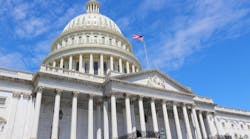This week: The House passed legislation to authorize defense programs, fund military facility construction and veterans’ programs for fiscal year (FY) 2017, and approve a down-payment of $622 million to fight the Zika virus. The Senate approved the FY-17 spending bills for military facility construction and veterans’, transportation and housing programs (see below) as well as various amendments to the bill.
Next week: The House will vote on a FY-17 funding bill for federal energy and water programs. The Senate will consider legislation authorizing defense programs. Senate leaders have also been discussing voting on a measure to repeal the Department of Labor’s fiduciary rule, and while this could occur next week or in June, the measure will be vetoed by President Obama.
Lead-in-Water Rulemaking In August. After heavy pressure from the White House and Capitol Hill, EPA moves up by several months the release of its proposed updates to the lead and copper rule, according to its spring regulatory agenda. The agency also expects to propose a rule in October and issue it in final form a year after that to implement the fledgling water infrastructure program that Congress created in 2014. The EPA has an aggressive slate of climate change and air pollution rules left to complete as it looks to lock in emissions reductions from power plants, refineries and the transportation sector in the Obama administration's remaining time in office. All of the rules that are expected to be acted on in the remainder of the Obama administration are now published in the current regulatory agenda.
EPA Issues Drinking Water Health Advisories for PFOS, PFOA. The EPA released voluntary benchmarks this week to guide local water systems, states and others in determining what concentration levels of certain highly fluorinated chemicals in drinking water are safe for public health. The EPA set the same benchmark—0.07 microgram per liter or 70 parts per trillion—in its two lifetime drinking water health advisories on perfluorooctane sulfonate (PFOS) and perfluorooctanoic acid (PFOA). Individual or combined exposure to the chemicals, which were previously widely used in products like carpets to make them more water- or stain-resistant, could result in negative health effects including cancer, the agency said. Reactions were mixed as to whether the health advisory levels that are lower than 2009 provisional levels for the chemicals are protective enough. But the advisories won't be the end of the issue: The EPA left the option open to develop enforceable rules on the chemicals.
Many California Cities Predict No Conservation Requirements Under New Water Rules. In stark contrast to the statewide calls for conservation last year in California, under new regulations many California cities are taking a second look at their water conservation efforts. The new rules adopted this week by the State Water Resources Control Board allow more than 400 urban water agencies to propose their own conservation standards. Agencies will "self-certify" a target based on their assessments of the health of their water supplies and anticipated local demand. Several California water agencies have said that based on the new rules, they expect their assessments to show they have plenty of water, and to largely back away from requiring customers to reduce water use tied to a specific target. Riverside, for example, gets its water from a huge groundwater basin that has been regulated for decades under a court adjudication that prevents it from being overdrawn. The city describes the 28 percent reduction in water use its agency was required to meet last year as "arbitrary and capricious.” The massive Metropolitan Water District of Southern California, said its 26 member agencies also are unlikely to set reductions close to the average savings of 22 percent they were ordered to meet last year. The District said its investments in storage, conservation, innovations and new water agreements over the years have left Metropolitan's member agencies positioned to meet expected demand. The "self-certification" process will require individual districts to forecast their local demand and supply for the next three years, assuming continued below-average precipitation. Districts would be required to reduce water use by an amount equal to their projected shortfall. For example, in a district where three more dry years would leave a district 10 percent short of anticipated supply, the mandatory conservation target would be 10 percent.
With Weather Warming, Flint Residents Warned of Legionnaires' Risk. The news for Flint residents keeps getting better as they are again being warned about the risk of Legionnaires’ disease, which increases as the weather warms up. At least a dozen people died during an outbreak after the city started using Flint River water in 2014. Usually Genesee County sees between 9 to 11 cases of Legionnaires’ in a year. But state officials say there were 91 cases of the disease during the summers of 2014-2015. The bacteria grows best in big, warm water systems - especially if they're not properly maintained. Still, state officials say they can’t definitively link the outbreak to the city’s water crisis. So far this year, there have not been any reported cases of Legionnaires’ but county health officials are working with local healthcare system to make sure that they do tests for Legionella on patients with related symptoms.
The news for Flint residents keeps getting better as they are again being warned about the risk of Legionnaires’ disease, which increases as the weather warms up.
Government Funding for 2017. Both the House and Senate are working on government funding bills for fiscal year 2017, which begins on October 1. This is important work since it is usually the only legislation Congress has to pass each year (if it wants a functioning government). The Senate passed its first bill last week covering most of the Department of Energy and civil works programs, and it approved two other funding bills this week. The more bills Congress and the President can agree on now, the fewer the departments and agencies that would be subject to a government shutdown threat at the end of September if partisan squabbles hijack the process then. The House and Senate will continue to focus most of their time on the 12 individual bills that cover the government’s discretionary funding needs until their summer recess in July. The public will hear about these bills through disagreements over very specific funding measures, such as this week’s largely partisan debate over Zika virus funding.
Senate Passes “Mini-Bus” Appropriations Bill. The Senate swiftly passed a $56.5 billion transportation-housing spending bill that retains controversial language establishing a 73-hour work week for truck drivers, which would change the DOT's “hours-of-service” rule. The fiscal 2017 Transportation, Housing and Urban Development bill (H.R. 2577) was bundled with a Military Construction and Veteran Affairs appropriations bill and $1.1 billion in Zika funding. The so-called minibus package passed on an 89-8 vote May 19, fulfilling Senate Majority Leader Mitch McConnell's (R-Ky.) plan to get it across the finish line by week's end. The Senate THUD bill would provide the Department of Transportation with $16.9 billion in discretionary funding and $44 billion for federal highway programs, including a new freight and highway grant program established under a five-year highway and transit law known as the FAST Act (Pub. L. No. 114-94). The measure also would fully fund the Federal Aviation Administration's air traffic control (ATC) division and block funding for a House-committee approved plan (H.R. 4441) to remove ATC from the agency and create a nonprofit organization. Overall, the appropriations bill would provide $827 million above enacted levels for fiscal year 2016, but still falls $3 billion below President Barack Obama's 2017 budget request.
Showdown on Terror Bill. The Senate this week unanimously passed legislation that would give victims of terrorism greater latitude to seek restitution from terrorist groups and parties that assist them. Most controversially, the bill essentially removes sovereign immunity, which would open up foreign governments to potential lawsuits. The Senate action occurs amidst an ongoing debate regarding the need to release classified materials that some allege draw a nexus between the September 11 terrorist attacks and the Saudi government. The Obama Administration has expressed concerns about this provision’s unintended consequences (including potential retaliatory actions by other nations) and has threatened to veto the bill. Interestingly, the Treasury Department also announced this week that the Saudi Government owns nearly $117 billion in U.S. debt. With the House likely to act in the coming weeks, Congress and the President appear to be on a collision course. While there undoubtedly will be negotiations to try to address the Administration’s concerns, Congress may be able to override a presidential veto if no agreement is reached.
House Republicans are putting the final touches on a proposed alternative to Obamacare that will be unveiled in the coming weeks.
Puerto Rico Debt Deal Begins to Move Forward But Challenges Remain. Congress took a big step toward finally addressing Puerto Rico’s debt crisis, though Republican and Democratic leaders now face the difficult task of holding together a fragile coalition to support the plan. The breakthrough support -- from the Obama White House as well as Republicans in Congress -- gives the plan for a new control board to oversee the territory’s finances a strong chance of success. The compromise represents a ray of hope for an island that has already defaulted on some of its $70 billion in debt and faces another $2 billion payment on July 1. Speaker Paul Ryan needs to get it through the House. But Ryan’s chances of success went up dramatically Thursday as U.S. Treasury Secretary Jacob J. Lew and House Democratic leader Nancy Pelosi signed on to the compromise bill released late Wednesday. Congress has already blown past one debt payment deadline on May 1, when the island defaulted on $370 million in bond payments. Now, an even heftier $2 billion payment by Puerto Rico comes due on July 1, and Governor Alejandro Garcia Padilla has warned that the commonwealth doesn’t have the money to make that payment in full.
Obamacare Alternative Coming. House Republicans are putting the final touches on a proposed alternative to Obamacare that will be unveiled in the coming weeks. The proposal will not likely be voted on since it would never proceed beyond the House, but it will instead serve as a contrast for voters to assess what type of health care system they may see under a Republican president and Congress in 2017. We do not expect the proposal to break much new ground. It will replace virtually all of Obamacare with a private system that is more focused on containing health care costs than expanding coverage. It will expand health care savings accounts and permit insurers to sell insurance across state lines. It will also likely contain tax credits for people with difficulty finding coverage, due either to pre-existing conditions or a lack of affordable options. It may also propose a capping of the employer tax exclusion for health care coverage of employees. The proposal will give Republicans an alternative to Obamacare to tout, but unless Republicans win big this year, it will be just a proposal.
UN Report Urges New Agenda for Resilient, Sustainable Cities. A recent report from the UN highlights the dramatic population shift to urban areas and its profound implications for energy consumption, politics, food security and human progress. While noting that two-thirds of the global population is expected to live in cities by 2030 and produce as much as 80 per cent of the global gross domestic product (GDP), the report demonstrates that the current urbanization model is unsustainable in many respects. As the urban population increases, the land area occupied by cities is increasing at a higher rate. It is projected that by 2030, the urban population of developing countries will double, while the area covered by cites could triple. The urban center of gravity, at least for megacities, has shifted to the developing regions. In 1995, there were 22 large cities and 14 megacities globally; by 2015, both categories of cities had doubled, with 22, or 79 per cent of the megacities located in Latin America, Asia and Africa. The fastest growing urban centers are the medium and small cities with less than one million inhabitants, which account for 59 per cent of the world's urban population.
Donor-Advised Funds. Donor-advised funds (DAF) are charitable vehicles that donors create with deposits of cash, securities or other assets. The DAF is maintained by the charity, but individual donors can advise how funds are invested and distributed. Some prefer a DAF to a private foundation because of its lower administrative requirements and operating costs. There is legislation in Congress that would make DAF donations a qualified charitable distribution from an IRA. The “Grow Philanthropy Act” was introduced by Congressman George Holding (R-NC) and highlighted in a hearing this week. A companion bill in the Senate includes several other provisions, such as disclosure and reporting requirements. If there is a broader tax bill that advances at the end of the year, there is a decent chance that this bill will be included.
TSA Woes. The past week’s intense media coverage of the long waiting lines at airports in the U.S., due in large part to a shortage of staffing at the Transportation Security Administration (TSA), has put the agency on the defensive. Congress recently approved a $34 million reprogramming of extra funds for TSA as the busy summer travel season looms. TSA will use the extra money to hire nearly 800 new screening officers and approve more overtime pay for current employees, but these are not long-term solutions. TSA’s employment problems—mostly lousy pay, low morale and constant turnover—cannot be solved overnight. Look for heavy congressional scrutiny of TSA in the near future and more announcements about other new initiatives to shorten the lines in the weeks ahead, but most are not optimistic anyone will see improvements in the short term at larger airports and hubs where long lines present a problem.
Dain M. Hansen is Senior Vice President, Government Relations, for The IAPMO Group. He may be reached at [email protected], 202/445-7514, www.Linkedin.com/in/DainHansen.


